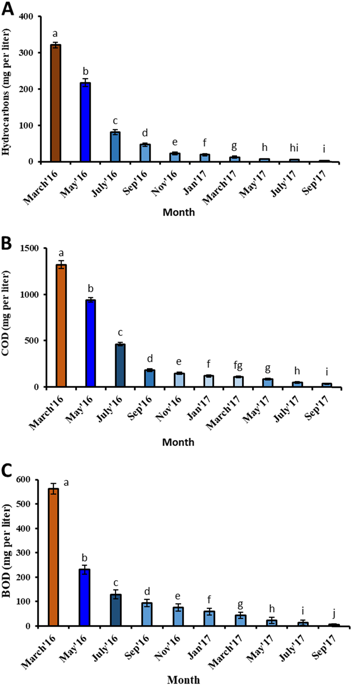npj Clean Water ( IF 10.4 ) Pub Date : 2019-01-10 , DOI: 10.1038/s41545-018-0025-7 Muhammad Afzal , Khadeeja Rehman , Ghulam Shabir , Razia Tahseen , Amna Ijaz , Amer J. Hashmat , Hans Brix

|
The contamination of water with hydrocarbons resulting from oil exploration and production highlights the need for efficient and environmentally friendly technology to mitigate this form of water pollution. Floating treatment wetlands are a sustainable approach for remediating contaminated water. In this large-scale study, we used four different plants, Phragmites australis, Typha domingensis, Leptochloa fusca, and Brachiaria mutica, to vegetate a floating mat with an area of 3058 m2 made from locally sourced materials. The floating treatment wetlands constructed in this manner were used to treat an oil-contaminated water stabilization pit resulting from oil and gas exploration activities in District Chakwal, Pakistan. The plants and the water in the pit were inoculated with a consortium of 10 different hydrocarbon-degrading bacteria. The application of floating treatment wetlands to the pit reduced chemical oxygen demand, biochemical oxygen demand, total dissolved solids, hydrocarbon content, and heavy metals by 97.4%, 98.9%, 82.4%, 99.1%, and 80%, respectively, within 18 months. All plants survived and showed growth, but maximum development and biomass production were exhibited by P. australis. Moreover, the bacteria used for inoculation were able to persist and show degradation activity in the water as well as in the rhizoplane, roots, and shoots of the plants. We conclude that floating treatment wetlands can be applied to oil-contaminated water stabilization pits for affordable and effective water treatment.
中文翻译:

使用浮动处理湿地大规模修复油污水
石油勘探和生产造成的碳氢化合物对水的污染突显了对有效和环保技术的需求,以减轻这种形式的水污染。浮动处理湿地是修复污染水的可持续方法。在这种大规模的研究中,我们使用了四种不同的植物,芦苇,长苞香蒲,千金子属裂孢菌,和巴拉草,种植树木到一个浮垫与3058米的区域2由当地采购的材料制成。以这种方式建造的漂浮处理湿地被用于处理巴基斯坦查克瓦尔地区的石油和天然气勘探活动所产生的被石油污染的水稳定坑。坑中的植物和水中都接种了由10种不同的可降解碳氢化合物的细菌组成的财团。浮动处理湿地在矿坑上的应用在18个月内分别减少了97.4%,98.9%,82.4%,99.1%和80%的化学需氧量,生化需氧量,总溶解固体,碳氢化合物含量和重金属含量80% 。所有植物均存活并显示出生长,但澳大利亚假单胞菌显示出最大的发育和生物量生产。此外,用于接种的细菌能够在水中以及植物的根际平面,根和芽中持久存在并表现出降解活性。我们得出的结论是,可将浮动处理湿地应用于受油污染的水稳定坑,以进行负担得起的有效水处理。











































 京公网安备 11010802027423号
京公网安备 11010802027423号